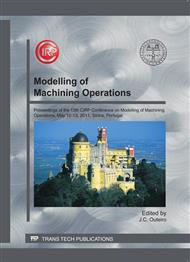p.277
p.286
p.296
p.304
p.314
p.325
p.332
p.340
p.350
Calibration of the Rheological Model Considering the Temperature in Milling Operation of Ti-6Al-4V: a Preliminary Analysis
Abstract:
The machining of titanium alloys is critical also because of high temperature reached at the tool nose. The temperature of the cutting tool affects the tool life and, in order to decrease the temperature, cutting speed is reduced. The prediction of temperature can allow designing the cutting process, in terms of cutting parameters, or make the best selection of the cutting tool, with reduced experimental effort. The rheological model is an important issue in the FEM simulation of cutting in order to achieve a good accuracy, In this paper the milling operation will be considered. This is very common in manufacturing and, often, it represents the last operation, determining the final product quality. Cutting forces, measured by dynamometer table, and temperature, measured by infrared camera, have been recorded during milling tests. The infrared camera captures a part of the workpiece close to the cutting edge. First the material model has been set up considering only cutting forces; next, a sensitivity analysis about the material model parameters has been performed in order to assess the influence of temperature in the determination of the material parameters.
Info:
Periodical:
Pages:
314-321
Citation:
Online since:
April 2011
Authors:
Keywords:
Price:
Сopyright:
© 2011 Trans Tech Publications Ltd. All Rights Reserved
Share:
Citation:


